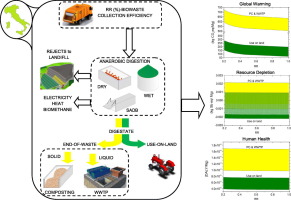当前位置:
X-MOL 学术
›
Sci. Total Environ.
›
论文详情
Our official English website, www.x-mol.net, welcomes your feedback! (Note: you will need to create a separate account there.)
How collection efficiency and legal constraints on digestate management can affect the effectiveness of anaerobic digestion of bio-waste: An analysis of the Italian context in a life cycle perspective.
Science of the Total Environment ( IF 9.8 ) Pub Date : 2020-04-08 , DOI: 10.1016/j.scitotenv.2020.138555 Francesco Di Maria 1 , Federico Sisani 1 , Mervat El-Hoz 2 , Ronald L Mersky 3
Science of the Total Environment ( IF 9.8 ) Pub Date : 2020-04-08 , DOI: 10.1016/j.scitotenv.2020.138555 Francesco Di Maria 1 , Federico Sisani 1 , Mervat El-Hoz 2 , Ronald L Mersky 3
Affiliation

|
The influence of collection efficiency and of legal regulations on both the technology and the effectiveness of energy and fertilizer recovery from the anaerobic digestion (AD) of bio-waste was investigated in a life cycle perspective for the Italian context. Concerning collection efficiency, some correlation was detected to both the AD technology and the amount of energy and fertilizer recovered. Nine out of 31 CE plants were based on solid anaerobic digestion batch located in those areas with collection efficiency <65%, recovering about 100 kg and 125 kWh of fertilizer and electricity, respectively, per Mg of bio-waste. The 17 plants adopting wet technologies were implemented in areas with collection efficiency ranging from 50% up to >85% able to recover on average about 130 kg of fertilizer and 275 kWh of electricity per each Mg of bio-waste. Wet AD was also the only adopted for larger size plants from 60,000 Mg/year up to 600,000 Mg/year. Legal constraint on the direct use on land of the digestate caused an average increase of main impacts such as global warming (kgCO2eq), freshwater eutrophication (kgPeq) and human health (DALY) of about 300%. The effect of the quality of the bio-waste returned after the collection showed lower incidence on the overall impacts of about 20%, and mainly limited to global warming (kgCO2eq) and photochemical ozone formation (kgNMVOCeq).
中文翻译:

收集效率和对消化管理的法律限制如何影响生物废物厌氧消化的有效性:从生命周期角度对意大利环境的分析。
从生命周期的角度,以意大利为背景,研究了收集效率和法律法规对生物废物厌氧消化(AD)技术和能源及肥料回收效率的影响。关于收集效率,AD技术与回收的能量和肥料量之间都发现了一些相关性。在31个CE工厂中,有9个工厂位于这些地区的固态厌氧消化批次中,收集效率<65%,每Mg生物废料分别回收约100 kg和125 kWh的化肥和电力。17个采用湿法技术的工厂已在收集效率从50%到> 每Mg生物废料平均可回收约130公斤化肥和275千瓦时的电量,占85%。湿法AD还被大型工厂采用,从60,000 Mg /年到600,000 Mg /年。法律对直接在土地上使用消化物的限制导致主要影响的平均增加,例如全球变暖(kgCO2eq),淡水富营养化(kgPeq)和人类健康(DALY)约300%。收集后返回的生物废物质量的影响表明,其对总体影响的发生率较低,约为20%,并且主要限于全球变暖(kgCO2eq)和光化学臭氧形成(kgNMVOCeq)。法律对直接在土地上使用消化物的限制导致主要影响的平均增加,例如全球变暖(kgCO2eq),淡水富营养化(kgPeq)和人类健康(DALY)约300%。收集后返回的生物废物质量的影响表明,其对总体影响的发生率较低,约为20%,并且主要限于全球变暖(kgCO2eq)和光化学臭氧形成(kgNMVOCeq)。法律对直接在土地上使用消化物的限制导致主要影响的平均增加,例如全球变暖(kgCO2eq),淡水富营养化(kgPeq)和人类健康(DALY)约300%。收集后返回的生物废物质量的影响表明,其对总体影响的发生率较低,约为20%,并且主要限于全球变暖(kgCO2eq)和光化学臭氧形成(kgNMVOCeq)。
更新日期:2020-04-08
中文翻译:

收集效率和对消化管理的法律限制如何影响生物废物厌氧消化的有效性:从生命周期角度对意大利环境的分析。
从生命周期的角度,以意大利为背景,研究了收集效率和法律法规对生物废物厌氧消化(AD)技术和能源及肥料回收效率的影响。关于收集效率,AD技术与回收的能量和肥料量之间都发现了一些相关性。在31个CE工厂中,有9个工厂位于这些地区的固态厌氧消化批次中,收集效率<65%,每Mg生物废料分别回收约100 kg和125 kWh的化肥和电力。17个采用湿法技术的工厂已在收集效率从50%到> 每Mg生物废料平均可回收约130公斤化肥和275千瓦时的电量,占85%。湿法AD还被大型工厂采用,从60,000 Mg /年到600,000 Mg /年。法律对直接在土地上使用消化物的限制导致主要影响的平均增加,例如全球变暖(kgCO2eq),淡水富营养化(kgPeq)和人类健康(DALY)约300%。收集后返回的生物废物质量的影响表明,其对总体影响的发生率较低,约为20%,并且主要限于全球变暖(kgCO2eq)和光化学臭氧形成(kgNMVOCeq)。法律对直接在土地上使用消化物的限制导致主要影响的平均增加,例如全球变暖(kgCO2eq),淡水富营养化(kgPeq)和人类健康(DALY)约300%。收集后返回的生物废物质量的影响表明,其对总体影响的发生率较低,约为20%,并且主要限于全球变暖(kgCO2eq)和光化学臭氧形成(kgNMVOCeq)。法律对直接在土地上使用消化物的限制导致主要影响的平均增加,例如全球变暖(kgCO2eq),淡水富营养化(kgPeq)和人类健康(DALY)约300%。收集后返回的生物废物质量的影响表明,其对总体影响的发生率较低,约为20%,并且主要限于全球变暖(kgCO2eq)和光化学臭氧形成(kgNMVOCeq)。



























 京公网安备 11010802027423号
京公网安备 11010802027423号